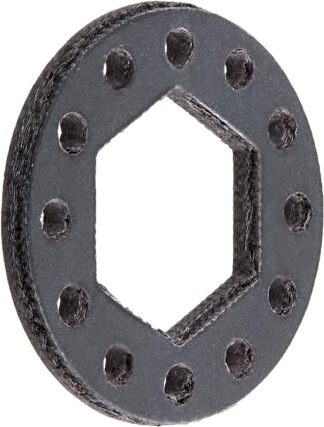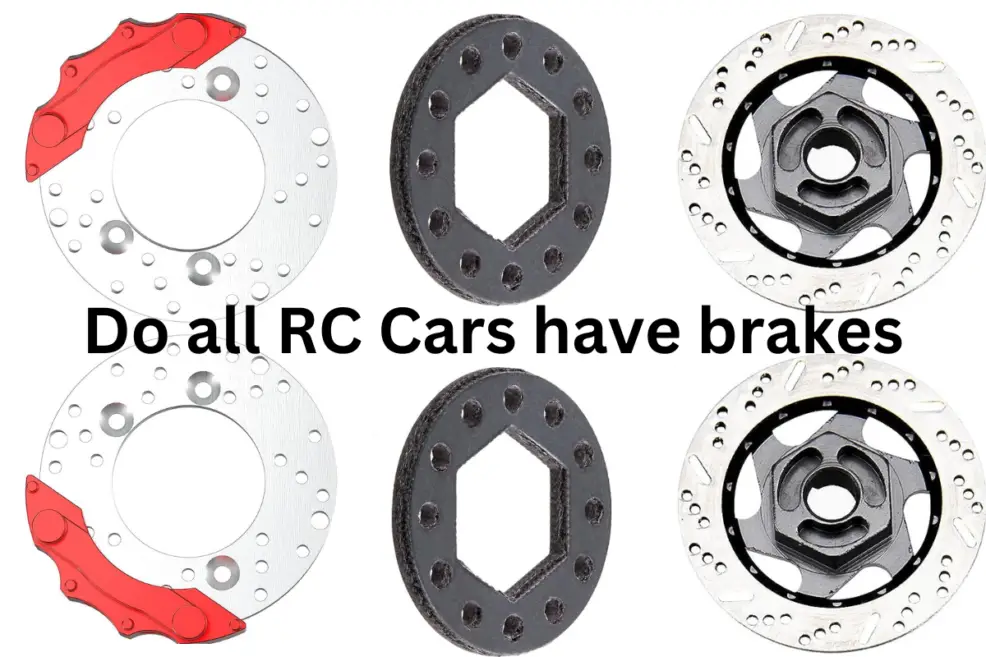By Joe Rich
Table of Contents
Do all RC Cars have brakes?
The short answer to that is “yes,” but to better understand how they work on each model, it requires a bit more of an investigation.
Importance of understanding the braking systems on RC cars.
Understanding the mechanics of Remote Control (RC) Cars, particularly the braking systems, is crucial for anyone passionate about these miniature speed machines. The braking system in an RC car isn’t just about stopping or slowing down; it’s a strategic tool that can significantly affect the vehicle’s performance and handling. For instance, some RC cars use electronic speed controllers (ESCs) for braking, which essentially reverse the motor’s direction, causing the car to slow down or stop.

On the other hand, nitro-fueled RC cars often have physical disc brakes, similar to those in real cars. Each system has its advantages. ESC braking provides excellent control and precision, ideal for executing tight turns and manoeuvres. In contrast, disc brakes offer more stopping power, making them better for high-speed racing.
By understanding these mechanics, enthusiasts can choose the right RC car for their needs and develop optimal braking techniques. It’s like learning to drive all over again, but this time, you’re in the driver’s seat of a high-speed, pint-sized race car. Mastering the art of braking can give you an edge in races, allowing for tight cornering and precise control that could be the difference between winning and losing.
Electric Powered RC Cars brakes
These are the most common kinds of RC cars available.
Generally speaking, this type of RC car uses a built-in battery that charges using some kind of port or by plugging it into an electrical outlet.
Charging times can vary based on usage and age of the battery.
But the more important question surrounding “do RC cars have brakes?” is how they work in the electric models.
Technically speaking, the electric RC models do not have brakes, at least not in the way that traditional cars have brakes.
Instead, the braking is performed by the speed control of the car.
This happens by making the motor essentially run as a generator and, in some of the more high-frequency speed controls, you can actually charge the batteries during the braking process.
The adjustment of the “brakes” takes place when you are adjusting both the speed control and the transmitter itself.
It is also worth noting that there are different types of transmitters for electric RC cars to consider.
For the pistol-grip variety of transmitters, all you have to do is push forward with your trigger finger to apply the brakes.
We have a article about RC car transmitters click here to read.
As opposed to the pulling motion that is required for the throttle, the motion for the brakes is much less sensitive and you essentially have an on-off control for the braking unless you have a great feel for the trigger.
There is also the amount of braking that occurs during neutral moments – when your finger is off the trigger – that are worth taking into account.
This ultimately controls how your car not only enters turns, but goes through them.
It is a process of figuring out how much pressure to apply and when to really get an understanding of how to appropriately use your braking system.
It isn’t like traditional brakes and it takes a bit of a learning experience to truly grasp the proper way to use it.
- 4 pole 12 slot high-torque motor design(NOTE: The product recommends using 2S (7.4V) batteries for the unit. Using a mismatched battery may result in the risk of burning out the electronics. )
- Precision engineered for maximum energy conversion
- Precision balanced rotor,smoothness for best reliability and maximum RPM
- Mutiple protection features: Low voltage cut-off protection, over-heat protection, throttle signal loss protection
- Suit for 1/10 scale RC car
We have a article about RC car motors click here to read.
How does ESC braking work?
Electronic Speed Control (ESC) braking in an RC car works quite differently than traditional braking systems found in regular vehicles. Instead of using a physical brake to slow down the wheels, ESC braking uses the motor itself to create resistance and slow the car down.
Here’s a simplified explanation of how it works:
- When the driver releases the throttle on the remote control, it sends a signal to the ESC.
- The ESC then reduces the power being sent to the motor.
- As the power decreases, the motor slows down, which in turn slows the wheels and the car.
- If the driver pushes the throttle in the opposite direction (towards the brake), the ESC understands this as a signal to reverse the motor’s direction. This creates even more resistance, causing the car to stop more quickly.
This system allows for precise control over the speed of the RC car, making it possible to execute tight turns and manoeuvres. However, it’s important to note that ESC braking doesn’t work as effectively when the battery is low, as there isn’t enough power to create the necessary resistance.
What is an RC Drag Brake?
In simple terms, drag brake in an RC car is a setting that applies a certain amount of brake automatically when you let off the throttle. It’s akin to engine braking in a full-sized car, where releasing the accelerator pedal causes the vehicle to slow down due to the engine’s resistance.
Benefits and Importance
Drag brake offers several benefits that make it essential for the smooth performance of an RC car. Firstly, it provides better control while decelerating, making the car more stable and reducing the chances of spinning out. This feature becomes particularly useful in off-road racing or on tracks with tight corners, where precise control over speed is vital.
Secondly, drag brake can also improve the car’s traction, allowing it to maintain a better grip on the surface, especially during downhill sections of a race.
Setting Up Your RC Drag Brake
The setup and settings of the drag brake will largely depend on the type of ESC (Electronic Speed Controller) your RC car uses. Most modern ESCs allow you to adjust the drag brake settings using a programming card or a compatible transmitter.
To set up the drag brake:
- Connect your ESC to the programming card or transmitter.
- Navigate to the drag brake settings.
- Adjust the percentage to increase or decrease the amount of drag brake applied. The higher the percentage, the stronger the braking effect when you release the throttle.
Remember, there’s no one-size-fits-all setting for drag brake. It would be best to begin with a lower setting and gradually increase it until you find the sweet spot that offers optimal control without adversely affecting the car’s handling.
Fine-Tuning Your RC Drag Brake
Fine-tuning your drag brake requires a bit of trial and error. Test your RC car on the type of terrain you’ll be racing on and adjust the settings accordingly. For instance, if you’re racing off-road, you may want a stronger drag brake to handle the rough terrain. Conversely, on a smooth, flat track, a lower setting might suffice.
Also, consider the type of car you’re driving. Heavier cars might require a higher drag brake setting to slow down effectively, while lighter cars might do well with a lower setting.
- Review, adjust and save Spektrum Smart ESC parameters
- Connect (via USB) to a PC to update Smart ESC firmware and adjust parameters via Spektrum SmartLink PC app
- Check a LiPo battery’s cell balance
- Needed to Complete: Compatible Spektrum Smart ESC and PC with internet access
Nitro Powered RC Cars brakes
Unlike the electric system, these have physical brakes that actually need to be maintained and cared for as they would on a traditional car.
They actually have little brake pads and discs – like a traditional car – that initiate the braking process.
Much like the electronic variation, too much braking can be a bad thing.
This is because the brake input can cause the wheel to lock up or excessive heating to the ESC as well as the motor.
We have a article about ESCs click here to read.
The question here isn’t “do RC cars have brakes?” it’s more “how do I tone down the brakes on my RC car?”
Perhaps the best way to do this is to use a medium-level or above radio.
This is because they have adjustable brake output and throttle settings, allowing you to lower the brake side.
This means that you can adjust the brakes more on the fly and are typically assigned to a button that allows you to “dial up” the brakes while you are driving the car itself.
By turning down the master brake settings, it allows you to find the settings that work best for you instead of having to conform to a pre-setting.
Like the brake controls, speed controls can be adjusted in the same manner.
This process has many different names – brake force, brake power, overall brake, brake feel, max brake, push brake, and so on – but they all achieve the same thing in the end.
Your car, provided you bought it from the store and not secondhand, should come with a manual.
The manual will elaborate on the type of setting that you need or are interested in, allowing you to cut out some of the guesswork in the process.
For more seasoned RC car enthusiasts, the manual can work in conjunction with some of the on-the-fly adjustments that are available in the RC car transmitter.
This allows for the precise feel that is unique to each driver.
Additionally, there are also brake tuning options to take into consideration.
Because there is so much involved in this process, it is simpler to try out all of the potential options available with this method.
Try using small changes as well as the full changes to get a better idea of the scope of these changes.
By testing each speed variation, as well as all of the options available, you can not only get a better feel for how they work, but for what they do as well. Sometimes, there is nothing better than experiencing these options rather than reading about them.
We have a article about electric and nitro powered RC cars click here to read.
Gas Powered RC Cars brakes
Gas powered RC cars tend to be a little more expensive because they function much the same as a normal car and can run so long as you have fuel for the car.
What’s crazy is that you can get very powerful motors that can leave your car running as fast as 60 MPH.
Much as the nitro and electric powered versions work through a transmitter, the same is true for the gas-powered version.
The difference is that the gas-powered cars have engines that are modelled after standard vehicles.
Unless you are taking apart the engine and reconstructing it, however, the real importance comes in the transmitter.
The transmitter is one of the universal aspects of RC cars of all types. It not only makes the car “go,” it controls the braking system as well.
In addition to the RC servo – which controls the steering of the RC car itself – the transmitter also has the brake lever that stops the car or allows it to slow down when going into turns so that speeds can be controlled more tightly.
The transmitter works basically the same as the nitro and electric counterparts, controlling the car’s ability to stop through those transmissions.
Generally speaking, the transmitters are all built in the same fashion so that controlling an RC car of any kind is straightforward.
We have a article about Nitro and gas powered RC cars click here to read.
- Top Quality Materials & Superb Craftsmanship
- Suitable for 1/10 RC on-road car
- Aluminum brake disc,Disc Diameter: 32mm
Replacing or Repairing the Braking Systems on RC cars
As covered in each of the sections, the braking systems inside the cars themselves can differ quite greatly depending on which car you go with.
This makes repairing or replacing those braking systems a challenge if you are not familiar with the three different types.
The quickest way to make adjustments to your braking system is through the adjustable brake output settings that come on your transmitter.
This allows you to find the best and most personalized control for your braking system so that you get the control that you desire.
But when it comes to the physical brakes themselves, this can be done by almost anyone thanks to video tutorials out there.
They are less complicated than your standard brakes on a traditional car, but they require patience and experience.
With the right tutorial of your car, you can see how to take apart the system, what parts to implement and how they fit specifically into the braking system of your RC car.
In conclusion, the braking system in an RC car plays a pivotal role, not only in controlling speed but also in enhancing the overall driving experience. Understanding how these systems work, whether it’s the electronic speed control (ESC) braking in electric cars or the physical disc brakes in nitro-fuelled cars, can significantly improve performance and precision. It allows drivers to make informed decisions about which RC car to choose based on their needs and racing style. Moreover, mastering the art of braking can provide a strategic edge during races, enabling tight cornering, swift manoeuvres, and controlled speeds.




